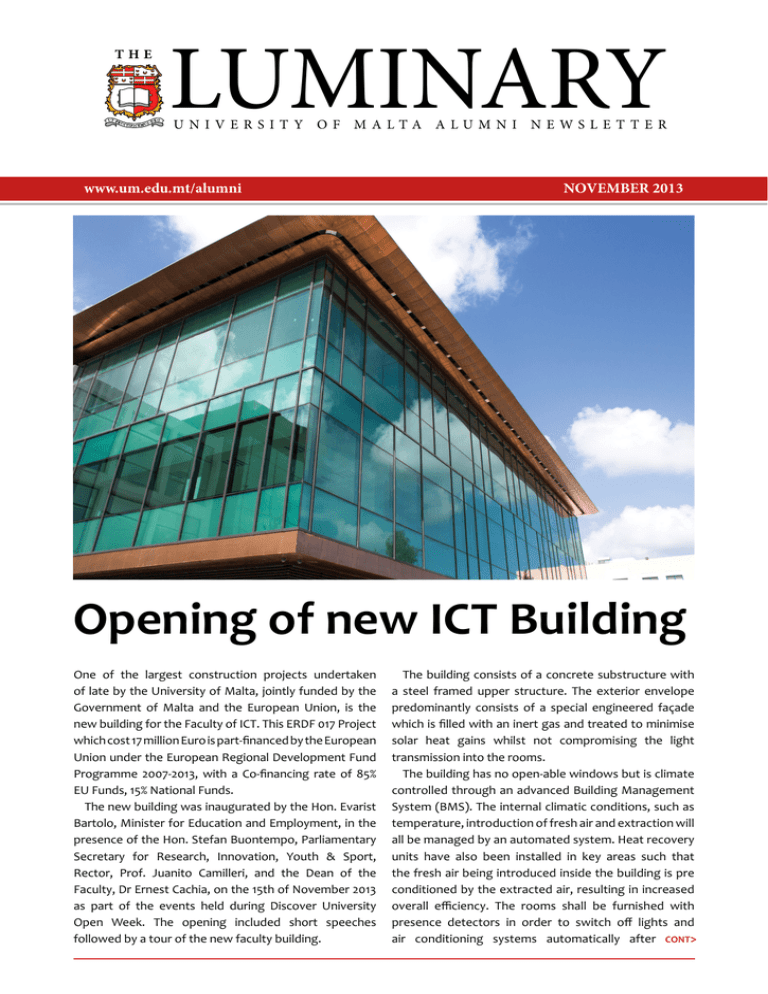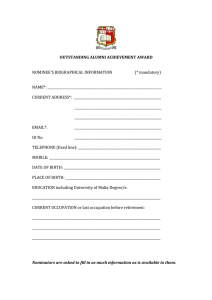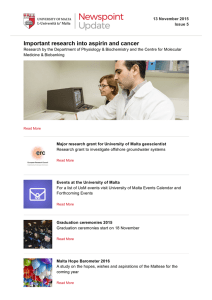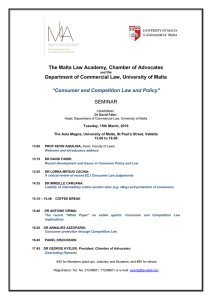LUMINARY Opening of new ICT Building NOVEMBER 2013 www.um.edu.mt/alumni
advertisement

THE LUMINARY UNIVERSIT Y OF MALTA ALUMNI NEWSLET TER www.um.edu.mt/alumni NOVEMBER 2013 Opening of new ICT Building One of the largest construction projects undertaken of late by the University of Malta, jointly funded by the Government of Malta and the European Union, is the new building for the Faculty of ICT. This ERDF 017 Project which cost 17 million Euro is part-financed by the European Union under the European Regional Development Fund Programme 2007-2013, with a Co-financing rate of 85% EU Funds, 15% National Funds. The new building was inaugurated by the Hon. Evarist Bartolo, Minister for Education and Employment, in the presence of the Hon. Stefan Buontempo, Parliamentary Secretary for Research, Innovation, Youth & Sport, Rector, Prof. Juanito Camilleri, and the Dean of the Faculty, Dr Ernest Cachia, on the 15th of November 2013 as part of the events held during Discover University Open Week. The opening included short speeches followed by a tour of the new faculty building. The building consists of a concrete substructure with a steel framed upper structure. The exterior envelope predominantly consists of a special engineered façade which is filled with an inert gas and treated to minimise solar heat gains whilst not compromising the light transmission into the rooms. The building has no open-able windows but is climate controlled through an advanced Building Management System (BMS). The internal climatic conditions, such as temperature, introduction of fresh air and extraction will all be managed by an automated system. Heat recovery units have also been installed in key areas such that the fresh air being introduced inside the building is pre conditioned by the extracted air, resulting in increased overall efficiency. The rooms shall be furnished with presence detectors in order to switch off lights and air conditioning systems automatically after CONT> THE LUMINARY NOVEMBER 2013 a predefined period of time, if these are left on when the room is vacated. The underground parking will be monitored and automatically ventilated. It is envisaged that this centralised climate control system, together with the use of the most advanced outer façade materials, will significantly reduce the energy demands of this building thus helping to minimise the environmental impact that the addition of another building on campus will have. In general, the airconditioning units are of VRF type using inverter driven compressors in order to optimise running efficiency under partial load conditions. Although the building houses its own dedicated electricity sub-station to ensure a stable supply of power, it is also equipped with a powerful Uninterrupted Power Supply (UPS) system, a standby generator for emergency power provision suitable to run all essential loads. Another feature of the building is its own rain water harvesting. Even in case of water supply interruption, the building can rely on its own voluminous subterranean water reservoir. This water reservoir shall be used to provide second class water for toilet use, provide water for irrigation purposes, as well as for fire fighting systems. The types of light fittings vary depending on the application and location, but in general they all provide a high lumen output per watt and are therefore energy efficient. The building is furnished with a PV array on the roof which shall serve the dual purposes of providing shading to the roof, thereby decreasing the 2 fabric heat gain and also generating power for direct use by the building. The building is also furnished with security and safety systems including a fire detection system, fire fighting system (with inert gas suppression in the server rooms), CCTV and access control. The structure itself is a four-floor edifice offering approximately 6700 sq. m. of floor space in total, configured as two blocks connected via a central multistorey entrance, lobby, stairwell, and lift area, with a ramp-accessed underground level 70+ car park. Attention was given to the overall skyline of the University’s Msida Campus. The sloped landscape surrounding the building minimised the visual impact on the surrounding university buildings. The various areas in the new building will include teaching labs, research rooms, tutorial rooms, undergraduate study areas, post-graduate rooms, research labs, and more. Honoris causa Ceremony Mr John Alfred Myers was a pioneer lecturer on the first Engineering degree course of the University of Malta and worked in Malta between 1964 and 1970. He was awarded the degree of Doctor of Engineering (Hon. causa). Dr Albert Ganado is best known as a keen collector of Melitensia and maps of Malta in particular. He has written extensively on the subject and on other aspects of Malta's history. Dr Ganado was awarded the degree of Doctor of Literature (Hon. causa). THE LUMINARY NOVEMBER 2013 3 Applied Creativity at Discover University - A Roaring Success! On Sunday 10th November, the Edward de Bono Institute participated in the Discover University Family Day with activities running throughout the whole event. Visitors of all ages were engaged in activities that focused on the development of everyday creativity. The range of activities included a shared effort in creating a drawing and a collaborative story-writing exercise where participants chose a word at random and incorporated it in a story. Another popular addition were the Puzzle Trees, where live trees were used to hang puzzles and brain-teasers and visitors were invited to choose one and come up with suitable answers. For photos and updates please visit and like us on Facebook, our Facebook page at https://www.facebook.com/debono.uom STREETS Project to improve accessibility to Malta and Sicily The STREETS Project was launched in October 2013 in Vittoria, Sicily. STREETS (STRatEgia IntEgrata per un Trasporto Sostenibile_Italia-Malta) is a 3-year project partly financed by the European Union European Regional Development Fund (ERDF) under the Operational Programme Italia-Malta 2007-2013. The project aims to improve the accessibility to both islands, while overcoming the current bottlenecks identified between the two islands. STREETS involves six partners, with the leading partner being the Regione Sicilia (Dipartimento Regionale delle infrastrutture, della mobilità e dei trasporti), together with Collegio Universitario ARCES, Vittoria Local Council, Catania Port Authority, Transport Malta and the University of Malta’s Institute for Climate Change and Sustainable Development. The Institute is responsible for a number of tasks which include an analysis of the territory and the traffic flows in and out of the port areas of Catania and Malta; the proposal of a draft joint strategy to determine current territorial problems; the identification of intermodal means of transport within the SicilianMaltese environment; an analysis of passengers and goods flows between Malta and Sicily; and the promotion of an integrated and sustainable transport solution. The STREETS launch conference took place in Vittoria with all project partners discussing progress so far. The University of Malta was represented by Dr Maria Attard (project coordinator), Ing. Luana Chetcuti Zammit, Ms Nicolette Formosa and Ms Deborah Mifsud (project research officers) and Ms Boglarka Toth (project administrator). At the conference Dr Attard presented the work being carried out in the development of a digital map of the transport network and the survey results gathered so far on the flow of passengers by air to and from Catania and Trapani. THE LUMINARY 4 NOVEMBER 2013 ERASMUS Students learn the Maltese Language Student life can present many motivating challenges, opening doors to many interesting opportunities. One can particularly see this in respect of students who have decided to embark on a first-time experience of a study period abroad, where culture, customs and language are unlike the norm, and far from the comforts of home. One of the aims of the Erasmus Intensive Language Courses (EILCs) offered by various Universities across Europe is to give ERASMUS students visiting European countries for studies and/or placements abroad, an opportunity to study the native language of the host country. The organisation of such courses is also seen as a way of enhancing and facilitating the integration process. Learning a less widely used and less taught language across Europe is yet another objective of the Erasmus Intensive Language Courses (EILC). The International & EU Office at the University of Malta has also taken in hand the organisation of an EILC in the Maltese language, presenting eighteen Erasmus students with an opportunity of attaining a general grasp of the Maltese language whilst acquiring an understanding of the language’s uniqueness and its origins. Participants were divided into two groups, with each course running in parallel, comprising of 60 hours of lectures followed by an assessment, which led to certification. The course was also accompanied by a series of visits to historical sites like the free standing temples of Hagar Qim, Mosta, Rabat, Mdina and the capital city of Valletta, a UNESCO world heritage site and European Capital for Culture 2018. Participants also had the opportunity of visiting Dingli Cliffs, Marsaxlokk, Wied iz-Zurrieq, Argotti Gardens as well as Nature Trust. Participants were awarded a certificate of merit which was presented to them at a ceremony celebrating Maltese Cuisine. The Director of the International & EU Office, Ms. Stefania Fabri awarded the certificates to the course participants in the presence of the International & EU Office staff and the students’ respective teachers. The project was funded through support received from the Commission of the European Communities within the framework of the Lifelong Learning Programme, (ERASMUS). GRADUATION 2013 Masses of Thanksgiving were held at St. John’s CoCathedral on the 13th and 14th November 2013. Mass was celebrated respectively by Bishop Mario Grech, Bishop of Gozo and Archbishop Paul Cremona, Archbishop of Malta. This year, nearly 3400 graduands are expected to graduate in various undergraduate and postgraduate disciplines. Nine Postgraduate Ceremonies are scheduled to be held in the Church of the University (Jesuits’ Church), Valletta while fourteen undergraduate ceremonies will take place in the Sir Temi Zammit Hall on the main Msida Campus. This year sees the graduation of the first students in several recently introduced courses. The Foundation Day Concert with the participation of the Malta Philharmonic Orchestra under the baton of Mro. Michael Laus, was held on 22nd November 2013 at the Mediterranean Conference Centre. This newletter is published by the Communications and Alumni Relations Office within the University of Malta. All Rights Reserved 2013


